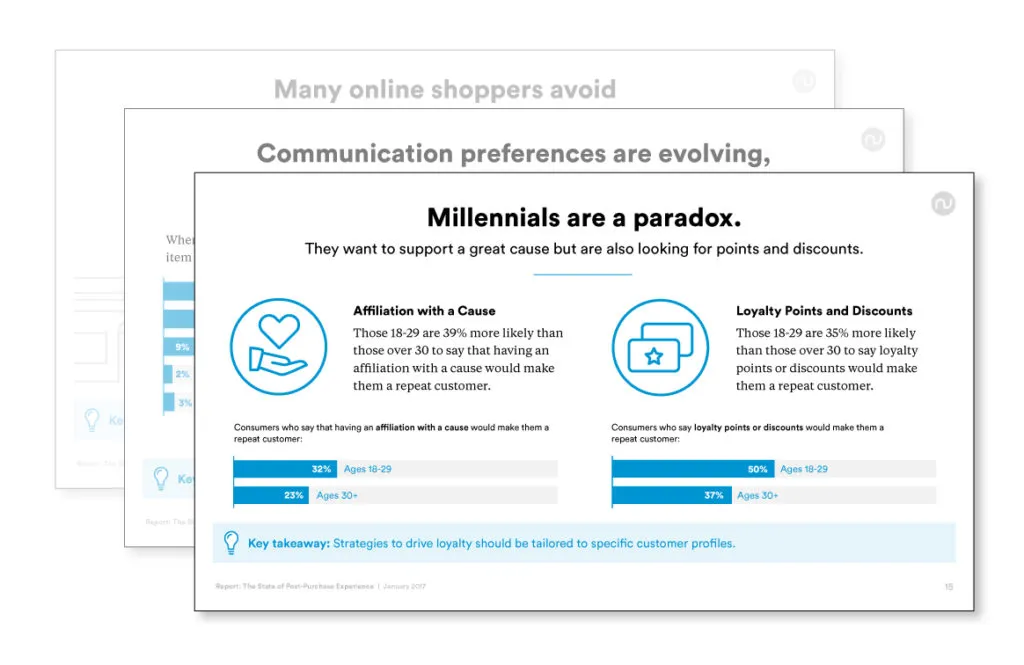
AI-powered delivery date estimates to boost conversion
Give shoppers peace of mind and protect and grow your bottom line
Personalized tracking experiences to build brand loyalty
Returns and exchanges management to mitigate fraud and reward best customers
Proactive communication to drive customer lifetime value
Delivery claim management to tackle fraud and build trust
Shoppers Prefer Effortless Commerce

State of Post-Purchase Experience Report finds 42 percent of shoppers don't trust their packages will arrive on time and nearly half expect their package might get damaged.
On-time delivery and easy returns ranked as key to influencing repeat purchases.
SAN FRANCISCO, CALIF., January 18, 2017 — Addressing anxiety after customers make a purchase is key in driving retail sales according to the State of Post-Purchase Experience Report published today by Narvar, a premium post-purchase experience platform. Narvar conducted a survey of more than 1,000 U.S. adults that have shopped online in the past year to analyze how they feel when engaging with brands in the critical new moment of truth between purchase and fulfillment and what this means for retailers.
Consumers will spend over $4 trillion in online retail by 2020, up from $1.5 trillion in 2015 according to eMarketer. Retailers have an opportunity to capture their share of this massive market, if they are able to evolve with consumers’ changing online shopping behaviors.
Shoppers are increasingly frustrated or anxious with online purchases and express concerns about damaged packages, on-time delivery, returns and more after they click buy. Almost half of shoppers (49 percent) worry about their package being damaged while in transit, and 42 percent of shoppers don’t trust that the package will arrive on time. A retailer’s ability to make the post-purchase experience seamless can be the difference between a one-time transaction and loyal, repeat customer.
The survey found that across the board, an on-time, easy delivery experience was ranked over loyalty points, responsive customer service, and association with a good cause, among others when it comes to becoming a repeat customer. Consumers also want to shop with companies that make the return process as painless as the purchase process; 70 percent of consumers saying an easy return or exchange is likely to make them a repeat customer.
“Shopping today can feel like a lot of work, and no longer delivers that sense of wonder or excitement it once had. This study shows that after people purchase is a critical time for brands to make the sure the experience is completely effortless,” says Amit Sharma, CEO of Narvar. “When done right, savvy retailers will be able inspire greater customer loyalty and repeat sales as a result.”

Key Findings from Narvar’s State of Post-Purchase Experience Report include:
The Amazon Effect is No Longer Unique to AmazonThe ‘Amazon Effect,’ the idea that Amazon’s fast and free shipping approach allows the company to differentiate itself and capture greater market share, is no longer exclusive to Amazon. Shoppers today hold all retailers (including Amazon) to the same high standards for the post-purchase experience. Retailers that are able to create effortless and engaging experiences after customers click buy have an opportunity to increase sales and customer loyalty.
- Both high-frequency and infrequent Amazon shoppers share the same preferences for post-purchase experience, spanning delivery expectations, returns process and communication channels.
- Having an item arrive on time is the No. 1 thing people said would make them a repeat customer of a brand, with 72 percent of people saying this would be a contributing factor.
- After getting an item on time, the next thing people care about most is being able to return it easily, with 70 percent of consumers saying an easy return or exchange is likely to make them a repeat customer.
Shipping Uncertainty and Hassle Plagues Shoppers Consumers have numerous anxieties related to the post-purchase experience, spanning delivery timing, trust, package damages and returns. These concerns are present year-long, though in-store anxiety exceeds shipping concerns during the holiday season. Retailers can create a better post-purchase experience by removing shipping uncertainty and hassle.Timing:
- Sixty percent of shoppers say that they will be more likely to choose a retailer that can tell them the exact date that the package will arrive at the time of order.
- Forty two percent of shoppers don’t trust that the package will arrive on time; they also say that delivering an item on time is the No. 1 thing retailers can do to encourage repeat shopping.
Damages:
- Almost half of the people surveyed (49 percent) worry about their package being damaged while in transit, more than any other post-purchase worry.
Returns:
- Sixty five percent of consumers want to print a label and send the item back themselves; this rises to 73 percent when looking at high percentage online shoppers.
Holiday Store Anxiety:
- During the holiday season, in-store anxiety exceeds any shipping concerns. Consumers are 28 percent less likely to choose in-store pickup during the holidays than they are during the rest of the year.
Communication Preferences Are Evolving, But Kindness Still Counts The way brands and shoppers interact has evolved dramatically over the years, as new technology offers opportunities for engaging in new and unique ways. With so many choices on where and how to engage, brands need to be aware of what different consumers are looking for from their retailers.
- While shoppers ages 18-29 prefer email, they’re more open to receiving communications through other channels. When compared to shoppers 45 and older, they’re 2.5 times more likely to want to interact through a retailer’s app, 3 times more likely to interact via Facebook Messenger, and 1.5 times more likely to interact via text/SMS.
- When asked what information would make them more satisfied with a purchase, 61 percent of people said ‘a simple thank you’ matters most, more so than including personalized recommendations, information on how to use the product better, or examples of how others are using the product.
20-somethings Crave Community, Even in Their ShoppingShoppers under the age of 30 have a unique set of preferences, shopping habits and beliefs that influence their purchasing decisions. Brands that want to reach this growing market of online shoppers need to be aware of their unique expectations from the brands they engage with.
- Those under 30 are 28 percent more likely to say that having an affiliation with a cause will make them more likely to be a repeat customer.
- Those under 30 are much more interested in seeing how others are using the same products than the general population. For instance, 37 percent of people in this age group said that examples of how others are using the product (e.g. photos) would make them more satisfied with their purchase, compared to 21 percent of those 30 and over.
- Those under 30 were more likely (50 percent) than general population (40 percent) to say loyalty programs would make them a repeat customer.
A report detailing the findings of the survey is available online at Narvar.com.
























